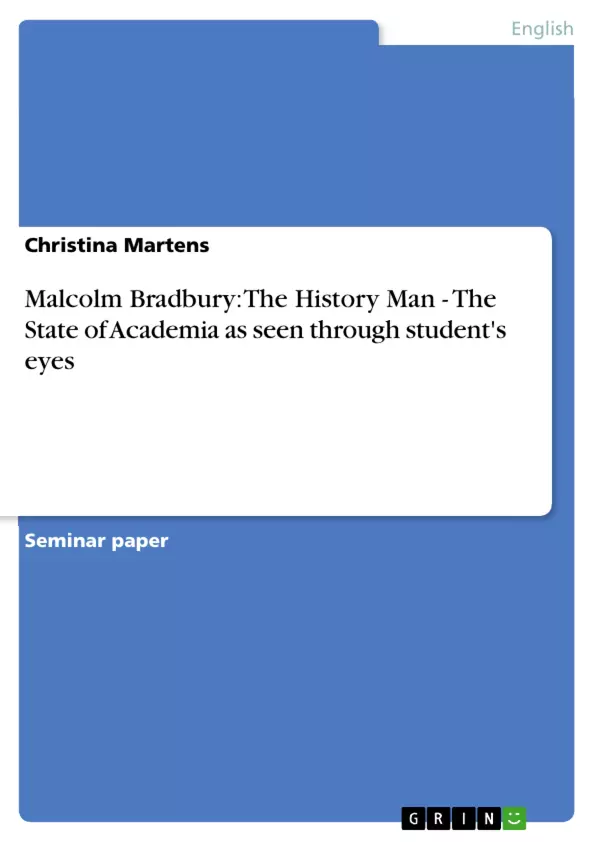The History Man is one of Malcolm Bradbury`s seven novels and it was published in 1975. This satiric novel belongs to the campus fiction of the seventies. A campus novel is determined by the history of an university. It mirrors problems and crises of the institution at that time. The meeting of students and lecturers in this kind of novel is an important feature. Those two groups constitute the social system of the university and build up the story, because every group makes different experiences in this institution. In an interview Malcolm Bradbury explained some of the tensions that lay behind The History Man. Within this novel he wanted to deal with some ironic processes of human behaviour. Therefore the author gives his characters some important trades.
The University of Watermouth is one of the new universities, because it was found after the war. This institution is an invention of the author. The main character is a lecturer of sociology, Doctor Howard Kirk. He does not want to teach history as it was, he just wants to make history after his own radical opinion. His aim is to revolutionize teaching and that is why his seminars are the means to an end for his political self-realization. Referring to the title of the book, Howard Kirk as the "History Man" influences the students not only in their view about the university, but also in their opinion about politics. That is why there are some advocates of his teaching methods, but also some opponents. The man influences some students so enormously that he is responsible for their opinion about the state of academia. This can be proved on the example of Felicity Phee, a student of Howard, two girls, who also study at the University of Watermouth, and George Carmody. Furthermore Doctor Kirk is characterized in the relationships to those people indirectly. He is shown in different parts, but he is always just interested in his own aims and not in the needs of other people.
Inhaltsverzeichnis (Table of Contents)
- The “History Man” and his great influence on other people
- Students of Watermouth and their relation to the university
- Felicity Phee
- The two girls
- The student George Carmody
- The tension of The History Man
Zielsetzung und Themenschwerpunkte (Objectives and Key Themes)
This novel explores the state of academia in the 1970s through the lens of student-lecturer interactions. Malcolm Bradbury uses satire to critique the changing social landscape of the university and the impact of radical teaching methods on student perspectives. The novel explores the irony of human behavior, particularly within the context of intellectual and social trends.
- The influence of a radical lecturer on students
- The role of fashion and conformity in student identity
- The impact of the sexual revolution on student relationships
- The tension between personal and professional boundaries within academia
- The complexities of social change and individual adaptation
Zusammenfassung der Kapitel (Chapter Summaries)
The first chapter introduces the main character, Doctor Howard Kirk, a sociology lecturer at the University of Watermouth, and explores his impact on students. It highlights his revolutionary teaching methods and his influence on student perspectives on both academia and politics.
The second chapter examines the student body of Watermouth, characterizing them as a generation that has lost its intellectual elite status and embraced a more conformist and trend-driven outlook. The chapter specifically focuses on Felicity Phee, a student of Doctor Kirk, and her struggle to navigate personal and academic challenges.
Schlüsselwörter (Keywords)
The key themes and concepts explored in this novel include campus fiction, the state of academia, radical teaching methods, student-lecturer interactions, conformity, fashion, the sexual revolution, and the complexities of social change and individual adaptation.
- Quote paper
- Christina Martens (Author), 2002, Malcolm Bradbury: The History Man - The State of Academia as seen through student's eyes, Munich, GRIN Verlag, https://www.grin.com/document/10441



